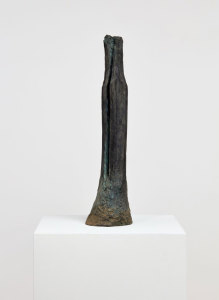ART-PRESENTATION: Beverly Pepper-New Particles From The Sun
 Beverly Pepper is known for her monumental works, site specific and land art, but she remains independent from any particular art movement. Her abstract forms that integrate fully into their environment, find a perfect balance between the materials and nature. The principal preoccupation of the artist has remained the same since her first creations – the temporal.
Beverly Pepper is known for her monumental works, site specific and land art, but she remains independent from any particular art movement. Her abstract forms that integrate fully into their environment, find a perfect balance between the materials and nature. The principal preoccupation of the artist has remained the same since her first creations – the temporal.
By Efi Michalarou
Photo: Kayne Griffin Corcoran Gallery Archive

In ancient Greek mythology, it was believed that metals came from the sky and were gifts from the Gods. Beverly Pepper in her solo exhibition “New Particles From The Sun” attempts to bridge the spirit of the fantastical with the logical, presenting works the artist created early on in her career between 1958 – 1967. During this period, Pepper carved out a niche in her own signature sculptural language. In addition to early works, the exhibition includes works from later years: 1970-80. At sixteen, Beverly Pepper entered the Pratt Institute in Brooklyn, New York to study advertising design, photography, and industrial design. She then embarked on a career as a commercial art director. She studied at the Art Students League of New York and attended night classes at Brooklyn College, including art theory with György Kepes, who introduced her to the work of Lasló Moholy-Nagy and Man Ray. It was also at this timethat she met the environmental artist Frederick Kiesler. Drawn to post-war Europe in 1949, she studied painting in Paris at the Académie de la Grande Chaumière. There she attended classes with cubist painter André L’Hôte, and with Fernand Léger at his atelier. She also visited the studios of Ossip Zadkine and Brâncuși. Pepper began her career as a painter, but after a trip to Angkor Wat, Cambodia in 1960, she was so awed by the temple ruins surviving beneath the jungle growth that she turned to sculpture. She made her debut in 1962 with an exhibit of carved tree trunks at a gallery in Rome. The same year Pepper was one of ten sculptors invited to participate in the momentous exhibition Sculture nella citta for the Festival of the Two Worlds in Spoleto. This event set her career on an advanced track. In Pepper’s conversation with Judith Olch Richards, as part of her oral history for the Archives of American Art, Pepper said “it was an absolute, seminal period of my life. It formed me. Remember, I was the only woman working in these factories as an artist for Spoleto. This was an extraordinary group of artists. I was getting another education. Because remember, I didn’t study sculpture. I didn’t’ study welding”. While in Spoleto, and working at factories throughout Italy, Pepper worked closely alongside Lynn Chadwich and Alexander Calder, as well as David Smith. She worked long hours in the studio and factories, learning how to manipulate different metals and weld. Her time apprenticing in mills was enough of an education that Pepper was in control of stainless steel to “draw” with it in space. She treated ribbons of metal as though they were weightless strokes of brush. Pepper became a sculptor who was on her own and speaking in her own voice. Her intuitive and fresh take on metal can be seen in this curated selection of work. She bends and splices the hard material as if it were something much more pliable. Through her self-taught, problem solving approach to making the work Pepper invented new forms and textures. The ribbon works, clusters and sheaths and bundles of bent steel, developed between 1958-62. Then came a far more geometrical series of open-faced stainless boxes, their edges violated by the abusive fire of torch cutting. The destructive mark of the torch on these 1965 works by Pepper partake in an instinct of pleasure at the idea of undermining the strength of steel: construction open to the terms of its own destruction. She also added colored enamel in some instances, bringing new life to the hard material. The later work in bronze was predicted in O’Hara’s 1965 poem when he writes, “as the lost wax process results in bronze masterpieces”. The exhibition focuses on this timeline of works both for their rarity and their significance to the narrative of American sculpture. Beverly Pepper’s work in metal, especially steel, places her in the rightful legacy of the pioneering and revolutionary sculptors celebrated throughout art history.
Info: Kayne Griffin Corcoran Gallery, 1201 S La Brea Avenue, Los Angeles, Duration: 12/1-9/3/19, Days & Hours: Tue-Sat 10:0-18:00, www.kaynegriffincorcoran.com

